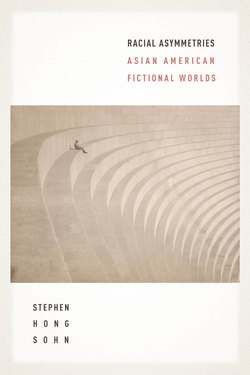Racial Asymmetries

Реклама. ООО «ЛитРес», ИНН: 7719571260.
Оглавление
Stephen Hong Sohn. Racial Asymmetries
About NYU Press
Отрывок из книги
Thank you for buying this ebook, published by NYU Press.
Sign up for our e-newsletters to receive information about forthcoming books, special discounts, and more!
.....
In the second chapter of Beyond Literary Chinatown (2007), Jeffrey F. L. Partridge investigates the consequences for writing in the post–Amy Tan era by comparing the book descriptions included on hardcover dust jackets or paperback covers of nine different narrative fictions produced by Chinese American writers, four of which are by Tan.23 Partridge concludes by arguing that literary marketers engender “the tour guide function” (73) promoting an ethnic authenticity. Yet Partridge chooses not to go beyond the Chinese American authors in exploring the tour guide function, which could demonstrate not only an ethnic commodification but a racialized one. Despite Partridge’s focus on one ethnic group, his approach persuasively shows how narratives are marketed in relation to authorial identity. Book-jacket descriptions, back-cover plot summaries, and Internet editorial blurbs describing the Chinese past as “hidden,” “tangled,” and “terrible” (73) call attention to an unassimilable origin point. This narrative heightens the inscrutability long attached to Asian American subjects as the yellow peril. While the American present is embraced and in some cases celebrated within these novels, the Asian ethnonational past is far more treacherous to navigate, so much so that many include various first-generation subjects who die. American identity then depends on a jettisoning of the hazardous past. The success of this kind of narrative demonstrates how Chinese American literature becomes commodified through marketplace practices. Such marketing approaches, of course, target what publishers consider a broad audience who will not likely have much familiarity with ethnic-minority contexts. Thus, the appeal of the tour guide narrative unfolds in the context of readers who look to begin a new and dynamic journey offered, apparently, only by the authentic storytelling voice.
This process can be elaborated more broadly within a racial context, as evidenced by the marketing approaches to several other novels not specific to the Chinese experience. The back-cover description to the paperback version of Lan Cao’s Monkey Bridge (1997), for example, illustrates how racial authenticity is rehearsed: “Lan Cao’s narrative traverses perilously between worlds past and present, East and West, in telling two interlocked stories” involving, among other things, a mother-daughter relationship and “family secrets.” The summary goes on to note that “the haunting and beautiful terrain of Monkey Bridge is the ‘luminous motion,’ as it is called in Vietnamese myth and legend, between generations, encompassing Vietnamese lore, history, and dreams of the past as well as of the future” (emphases mine). The binary that structures East and West is telling, despite the different ethnic context, in which Vietnam stands in for the threatening Asian past. As Partridge details in the case of Chinese American literature, so many of these mother-daughter descriptions are leveraged on a “secret” often detailed or existing in conjunction with an Asian ethnic heritage. The revelation of the secret enables the main character to undergo a kind of healing (73). In Monkey Bridge, the daughter, Mai Nguyen, one of two narrators, must confront her mother’s past to find out why her grandfather did not join them in the United States. This “secret” propels the novel forward and requires readers to delve into the traumas of the Vietnam War. Monkey Bridge is one of numerous examples external to the Chinese American context wherein the writer is marketed as the tour guide.24 The writer leads readers into the Asian past and then delivers them safely away from it.
.....